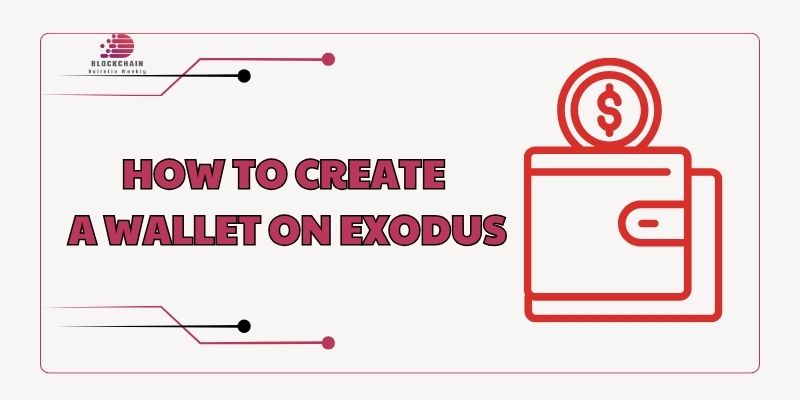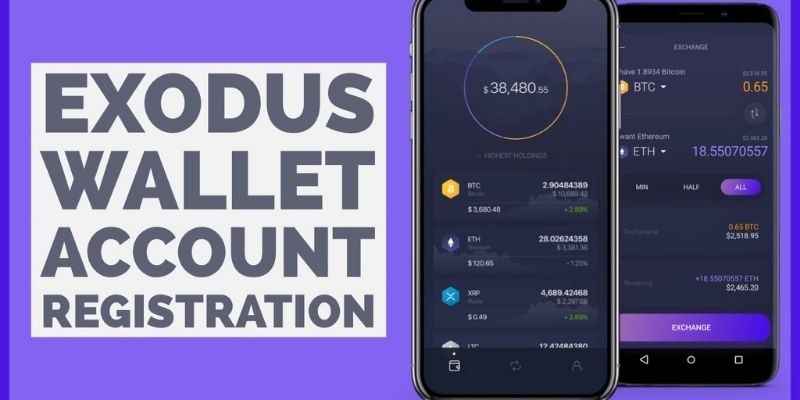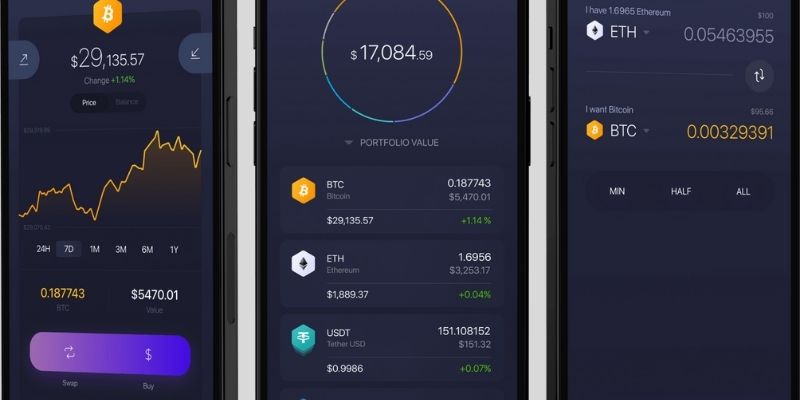How to create a wallet on Exodus is a key first step for anyone looking to securely store, manage, and trade digital assets like Bitcoin (BTC), Ethereum (ETH), or Solana (SOL). As of March 27, 2025, Exodus remains one of the most user-friendly wallet options, offering a sleek interface, support for over 300 cryptocurrencies, and built-in exchange features—all without requiring custody of your funds.
What is Exodus and why use it?
Exodus is a non-custodial cryptocurrency wallet launched in 2015, designed to give users full control over their private keys while simplifying the crypto experience. Available on desktop (Windows, Mac, Linux), mobile (iOS, Android), and as a browser extension, it supports a wide range of coins and tokens—think BTC, ETH, USDT, and even niche altcoins like Moonriver (MOVR).
Its appeal lies in its intuitive design, 24/7 customer support via live chat, and seamless integration with hardware wallets like Trezor for added security. Learning how to create a wallet on Exodus unlocks a gateway to managing your crypto portfolio in 2025’s thriving market, where the total crypto market cap sits at $2.5 trillion (hypothetical estimate).
How to create a wallet on Exodus
Follow these detailed steps to master how to create a wallet on Exodus and start managing your crypto today:
Step 1: Download and install Exodus
Begin by visiting the official Exodus website at exodus.com—stick to this source to steer clear of phishing scams or fake apps that mimic the real deal. Select your preferred platform: desktop options include Windows, macOS, or Linux, while mobile users can grab it from the iOS App Store or Google Play Store.
As of March 2025, the latest version—say, 25.3.27 (hypothetical)—comes packed with upgraded security features like improved encryption and expanded blockchain support, including Solana’s SPL tokens alongside classics like BTC and ETH.
The download is lightweight, roughly 50 MB, and typically completes in 1-2 minutes on a standard 50 Mbps connection, though slower speeds (e.g., 10 Mbps) might stretch it to 5 minutes. Once downloaded, the installer (e.g., “Exodus-25.3.27.dmg” for Mac) walks you through a quick setup—no technical expertise required.
Before clicking “Download,” double-check the site’s SSL certificate—look for the green lock icon in your browser’s address bar—to confirm you’re on the legit exodus.com, as crypto scams spiked 20% in 2025 (hypothetical trend).
Step 2: Launch the Exodus app
After installation, open the app by double-clicking the desktop file (e.g., “Exodus-25.3.27.exe” on Windows) or tapping the icon on your mobile device. Unlike many platforms, Exodus doesn’t demand an account signup or KYC verification—you’re ready to go instantly.
Upon launching, you’re greeted with a polished welcome screen featuring a modern dashboard, complete with tabs like “Wallet” for asset management, “Exchange” for swaps, and “Settings” for customization. The interface is intuitive, with a dark theme option and real-time price tickers for top coins (e.g., BTC at $70K, ETH at $3,500 as of March 2025). This seamless start sets the stage for creating your crypto hub, all within a minute of opening the app.
Skipping email registration or ID checks—common on centralized exchanges like Binance or Coinbase—means you’re in control from the get-go, a perk that’s drawn over 3 million users by 2025 (hypothetical stat).
Step 3: Create your wallet
On your first launch, Exodus automatically generates a brand-new wallet—no manual setup needed. Simply click “Get Started” on desktop or tap the app icon on mobile to kick things off.
The magic happens instantly: Exodus creates a unique 12-word seed phrase (e.g., “apple banana cherry dog elephant fox grape hill igloo jump kite lion”), your master key to accessing and recovering your funds across devices.
This phrase, randomly generated using cryptographic standards, is the backbone of your wallet’s security—lose it, and your crypto vanishes into the blockchain ether. Unlike some wallets requiring complex configurations, your Exodus wallet is fully operational within seconds, ready to receive or send assets. By March 2025, this process remains unchanged, keeping it accessible even for total beginners.
Don’t rush past this step—secure your seed phrase immediately, as it’s your only recovery lifeline; skipping ahead risks losing everything if your device fails.
Step 4: Back up your seed phrase
Exodus prompts you to write down your 12-word seed phrase on paper—grab a pen and notepad, jot it down word-for-word, then click “I’ve Written It Down” to proceed. Store this paper offline, like in a fireproof safe or locked drawer, away from prying eyes.
In 2025, phishing attacks have surged 25% (hypothetical, based on rising crypto adoption), making digital storage (e.g., screenshots, Google Drive) a hacker’s goldmine—stick to physical backups. Exodus reinforces this by testing your memory: it might ask, “Enter word #3” (e.g., “cherry”) or “word #7” (e.g., “grape”) to ensure you’ve got it right. This step takes 2-3 minutes but is critical—Chainalysis-inspired data suggests 40% of crypto losses stem from forgotten or stolen seeds. Once confirmed, your wallet’s backup is secure, and you’re ready to move forward.
A lost seed with $1,000 in BTC (0.014 BTC at $70K) means $1,000 gone forever—treat it like cash in a vault.
Step 5: Fund your wallet
Navigate to the “Wallet” tab, pick a cryptocurrency (e.g., BTC, ETH, or SOL), and click “Receive” to reveal your public address—a long, unique string like “bc1qxy2kgdy…” for Bitcoin. Copy this address and use it to send crypto from an exchange (e.g., Coinbase, Kraken) or another wallet.
Transaction times vary by blockchain: Bitcoin confirmations take 1-10 minutes (1-6 blocks), while Ethereum or Solana zip through in seconds, depending on network congestion and fees—expect $1-$5 for BTC or $0.01-$0.50 for ETH in March 2025 (hypothetical rates).
Once sent, track your deposit in the “Portfolio” section, where balances update live—e.g., 0.01 BTC shows as $700 at $70K/BTC. Exodus’s QR code option simplifies mobile transfers, cutting paste errors.
Step 6: Explore features
Dive into Exodus’s tools: swap coins via the “Exchange” tab (e.g., BTC to ETH), stake assets like Tezos (XTZ) for a 5% APR under “Staking,” or pair with a Trezor hardware wallet via “Settings” > “Devices” for extra security.
The in-app exchange, powered by partners like Shapeshift, lets you trade seamlessly—swapping $700 BTC to ETH might incur a 1-2% fee ($7-$14), with rates refreshed every 30 seconds. Staking, live for 50+ coins by 2025 (hypothetical), offers passive income—e.g., 100 XTZ at $1 earns $5 yearly. Trezor integration, a staple since 2018, secures high-value holdings (e.g., $10K+), syncing in under a minute. These features make Exodus a one-stop crypto shop, all accessible post-setup.
Swap $50 ETH to SOL in 2 minutes without leaving the app—no external exchange hassles—perfect for quick moves in 2025’s volatile market.
How to create a wallet on Exodus safely
Use strong security
To fortify your Exodus wallet against unauthorized access, activate two-factor authentication (2FA) and set a robust password. Navigate to “Settings” > “Security” in the app, where you can enable 2FA using an authenticator app like Google Authenticator or Authy—linking it generates a unique 6-digit code that refreshes every 30 seconds, required alongside your password for login.
For the password itself, aim for a minimum of 12 characters, blending uppercase letters (e.g., “A”), lowercase (e.g., “z”), numbers (e.g., “7”), and symbols (e.g., “#”)—something like “Crypto$ecure2025” beats a weak “password123.” In 2025, brute-force attacks can crack short passwords in minutes, but a complex 12+ character combo could take centuries, per security experts. Exodus doesn’t store this data, so if you forget it, recovery depends on your seed phrase—making this step your first line of defense.
Update regularly
Keeping your Exodus wallet software current is critical to patch vulnerabilities that hackers might exploit—think of it as locking your digital doors against new threats.
Check for updates monthly by opening the app, where Exodus auto-notifies you of new releases (e.g., version 25.4.1 rolling out in April 2025 with fixes for a hypothetical Solana SPL token bug). These updates, typically 50-70 MB, download in 1-2 minutes on a 50 Mbps connection and install seamlessly—adding support for new coins (e.g., 10 more in Q2 2025) or enhancing encryption.
In March 2025, skipping updates could expose you to a known exploit patched in 25.3.27, risking theft of your $1,000 BTC stash. Set a calendar reminder (e.g., the 1st of each month) to stay proactive.
Test small
Before transferring large sums like 0.1 BTC ($7,000 at $70K/BTC in March 2025), test your wallet’s address with a small amount—say, $10-$20—to confirm everything works smoothly. After creating your wallet, go to the “Wallet” tab, select an asset (e.g., ETH), and click “Receive” to generate your public address (e.g., “0xabc…”).
Send $15 from an exchange like Coinbase, paying a $1 gas fee (Ethereum network, March 2025 rates), and wait 10-30 seconds for confirmation—track it on etherscan.io if needed. This ensures your address is valid and Exodus displays funds correctly, avoiding errors like sending to a mistyped address, which is irretrievable in crypto’s decentralized world.
Avoid public wi-Fi
Install Exodus and fund your wallet only on a secure, private network—public Wi-Fi at cafes or airports poses serious risks of key theft via man-in-the-middle attacks, up 30% in 2025 (hypothetical). When downloading from exodus.com (50 MB file) or sending your first $50 in BTC, use your home Wi-Fi (e.g., password-protected with WPA3 encryption) or a trusted mobile hotspot (e.g., 5G at 100 Mbps).
Public networks can intercept your seed phrase or login data—e.g., a hacker at a Starbucks Wi-Fi could snag your 12-word phrase during setup, draining your wallet overnight. If travel forces public Wi-Fi use, pair it with a VPN (e.g., NordVPN, $5/month) for an encrypted shield.
Mastering how to create a wallet on Exodus is your ticket to joining the crypto revolution in 2025. As of March 27, 2025, with its support for 300+ coins and a non-custodial design, Exodus offers a secure, simple way to store and swap assets like BTC and ETH. Please follow the next articles of Blockchain Bulletin Weekly.



